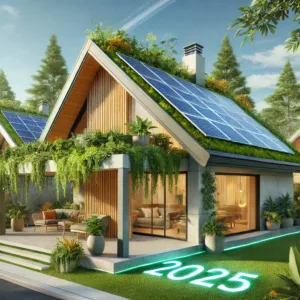
As environmental consciousness continues to rise, homeowners are seeking ways to reduce their ecological footprint—starting with their homes. Roofing, an essential component of any structure, has a significant impact on energy efficiency and sustainability. If you’re considering a roof upgrade, exploring green roofing materials and sustainable roofing solutions is a great step towards a more eco-friendly home. Here’s a comprehensive guide to eco-friendly roofing options for 2025.
- Metal Roofing: Durable and Recyclable
Metal roofs are among the most sustainable roofing options available. Made from materials like steel, aluminum, or copper, metal roofs are highly durable, often lasting 40-70 years. Additionally, most metal roofing materials are recyclable at the end of their lifespan, reducing landfill waste.
Why Choose Metal Roofing?
- Reflects solar heat, reducing energy costs
- High durability and low maintenance
- Recyclable and often made from recycled materials
- Cool Roofs: Reflective and Energy-Efficient
Cool roofs are designed to reflect more sunlight and absorb less heat than standard roofing materials. They’re typically made with reflective coatings or lighter-colored tiles and can significantly lower energy bills, especially in warmer climates.
Benefits of Cool Roofs:
- Reduced energy consumption
- Increased indoor comfort during summer months
- Lower urban heat island effect
- Living Roofs: Green Roof Systems
Living roofs, also known as green roofs, involve growing vegetation over a waterproof membrane on the roof’s surface. These eco-friendly roofing solutions offer insulation, reduce stormwater runoff, and improve air quality.
Advantages of Living Roofs:
- Natural insulation and temperature regulation
- Supports biodiversity in urban areas
- Aesthetic and environmentally beneficial
- Solar Roofing: Harness the Power of the Sun
Solar roofing, including solar panels and solar shingles, is a sustainable solution that allows homeowners to generate renewable energy. While the initial investment can be high, solar roofs often pay for themselves over time through energy savings and potential tax incentives.
Why Go Solar?
- Reduces reliance on non-renewable energy sources
- Lower energy bills
- Increases property value
- Recycled Roofing Materials: From Waste to Wonder
Recycled roofing materials, such as shingles made from rubber, plastic, or wood fiber, are a fantastic way to repurpose waste products. These materials are not only durable but also help keep non-biodegradable waste out of landfills.
Key Features:
- Environmentally friendly production
- Long-lasting and cost-effective
- Variety of styles and colors
- Clay and Concrete Tiles: Natural and Timeless
Clay and concrete tiles are sustainable roofing solutions with a long lifespan. They are made from abundant natural materials and can often be recycled at the end of their use.
Benefits of Clay and Concrete Tiles:
- High durability and resistance to weather
- Energy-efficient due to thermal properties
- Aesthetic appeal for various architectural styles
- Asphalt Shingles with Cool Coating
Traditional asphalt shingles can be made eco-friendly by applying cool coatings to increase reflectivity. Look for shingles made from recycled materials for an even greener option.
Why Choose Asphalt Shingles?
- Affordable and widely available
- Variety of styles and colors
- Upgraded energy efficiency with cool coatings
Choosing the Right Eco-Friendly Roofing Option
When selecting a sustainable roofing solution, consider your local climate, budget, and long-term energy savings. Consulting with a professional roofing contractor can help you determine the best option for your needs.
Final Thoughts
Switching to eco-friendly roofing materials not only benefits the planet but can also reduce energy costs and increase your home’s value. By investing in sustainable roofing solutions, you’re taking an important step towards a greener future. Explore these options in 2025 and transform your home into an eco-friendly haven.

